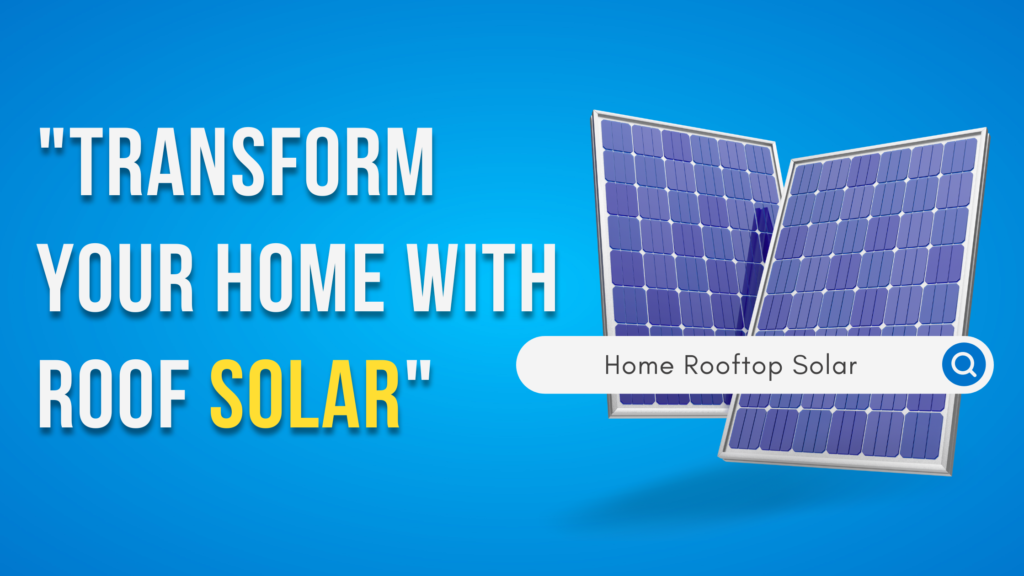"Maximize Savings and Efficiency with Roof Solar Solutions"
In today’s world, where energy costs are rising and environmental concerns are becoming more pressing, many homeowners are seeking sustainable and cost-effective energy solutions. One of the most popular and efficient ways to achieve this is by installing a roof solar system. Roof solar installations not only help in reducing electricity bills but also contribute to a greener environment. In this blog, we will delve into the benefits of roof solar solutions, how they maximize savings and efficiency, and the steps involved in setting up a solar panel system on your roof.
Introduction
Roof solar systems have gained significant popularity over the past decade due to their ability to harness the sun’s energy and convert it into electricity. This renewable energy source is not only abundant but also free, making it an excellent alternative to traditional fossil fuels. With advancements in technology and increasing awareness about environmental sustainability, more homeowners are considering roof solar installations as a viable option. In this blog, we will explore the various aspects of roof solar systems, from their financial benefits to their environmental impact, and provide a comprehensive guide on how to get started.
The Financial Benefits of Roof Solar Solutions
One of the primary reasons homeowners opt for roof solar systems is the potential for substantial cost savings. Here’s how a roof solar installation can maximize your savings:
1. Reduction in Electricity Bills: By generating your own electricity, you can significantly reduce your reliance on the grid. This means lower monthly electricity bills. Depending on the size of your roof solar system and your energy consumption, you could save hundreds or even thousands of dollars annually.
2. Tax Incentives and Rebates: Many governments offer incentives to encourage the adoption of renewable energy. These can include federal tax credits, state rebates, and local incentives. For example, in the United States, the federal Investment Tax Credit (ITC) allows homeowners to deduct a significant percentage of their solar installation costs from their federal taxes.
3. Increase in Property Value: Homes equipped with roof solar systems often have higher property values. Potential buyers recognize the long-term savings and environmental benefits, making such properties more attractive in the real estate market.
4. Net Metering Programs: In many regions, homeowners with roof solar systems can participate in net metering programs. This allows you to sell excess electricity generated by your solar panels back to the grid, further offsetting your energy costs.
Maximizing Efficiency with a Solar Panel System
Efficiency is a crucial factor when considering a roof solar installation. Here are some ways to ensure your solar panel system operates at its maximum potential:
1. Quality of Solar Panels: Not all solar panels are created equal. Investing in high-quality panels with better efficiency ratings can produce more electricity even in limited space. Look for panels with high efficiency and a good warranty.
2. Professional Installation: The installation of your roof solar system should be carried out by experienced professionals. Proper installation ensures optimal panel orientation and minimizes potential shading issues, which can significantly impact the system’s performance.
3. Regular Maintenance: Although solar panels require minimal maintenance, keeping them clean and free from debris is essential for optimal performance. Regular inspections can help identify and rectify any issues before they affect efficiency.
4. Energy Storage Solutions: Pairing your roof solar system with energy storage solutions like solar batteries can maximize efficiency. These batteries store excess energy produced during the day for use at night or during cloudy periods, ensuring a constant power supply.
5. Energy Consumption Management: Being mindful of your energy consumption patterns can also help maximize the efficiency of your solar panel system. Simple steps like using energy-intensive appliances during peak sunlight hours can make a significant difference.
The Environmental Impact of Roof Solar Systems
Beyond financial savings, roof solar solutions play a crucial role in reducing environmental impact. Here’s how:
1. Reduction in Carbon Footprint: Solar energy is a clean, renewable source that doesn’t produce harmful emissions. By switching to a roof solar system, you can significantly reduce your household’s carbon footprint, contributing to a healthier planet.
2. Decrease in Fossil Fuel Dependence: Traditional electricity generation relies heavily on fossil fuels like coal and natural gas. By generating your own electricity through a solar panel system, you decrease the demand for these non-renewable resources, helping to conserve them for future generations.
3. Promotion of Sustainable Practices: Adopting a roof solar system sets a positive example for your community. It encourages others to consider sustainable energy solutions, amplifying the environmental benefits on a larger scale.
Steps to Setting Up a Roof Solar System
Installing a roof solar system is a significant investment that requires careful planning and execution. Here are the steps to guide you through the process:
1. Initial Assessment: The first step is to assess your roof’s suitability for solar panels. Factors to consider include the roof’s orientation, size, and condition. A professional solar installer can conduct a thorough assessment to determine the best setup for your home.
2. Choosing the Right System: Based on the assessment, you’ll need to choose the appropriate solar panel system. Consider factors such as your energy needs, budget, and available incentives. Research different types of panels and inverters to find the best fit.
3. Financing Options: Explore various financing options for your roof solar system. These can include outright purchase, solar loans, or solar leases. Each option has its pros and cons, so it’s essential to choose one that aligns with your financial situation.
4. Permitting and Installation: Once you’ve chosen a system and secured financing, the next step is to obtain the necessary permits. Your solar installer will typically handle this process. After permits are in place, the installation can proceed. This involves mounting the panels, connecting the inverter, and integrating the system with your home’s electrical setup.
5. Inspection and Activation: After installation, the system must be inspected and approved by local authorities. Once approved, your roof solar system can be activated, and you can start generating your own electricity.
Conclusion
Roof solar solutions offer a myriad of benefits, from substantial cost savings to significant environmental impact. By investing in a solar panel system, you not only reduce your electricity bills but also contribute to a more sustainable future. The journey to installing a roof solar system involves careful planning, choosing the right components, and ensuring professional installation. As technology continues to advance and incentives become more attractive, there has never been a better time to consider harnessing the power of the sun. Embrace the future of energy with a roof solar system and enjoy the rewards of maximizing savings and efficiency.


